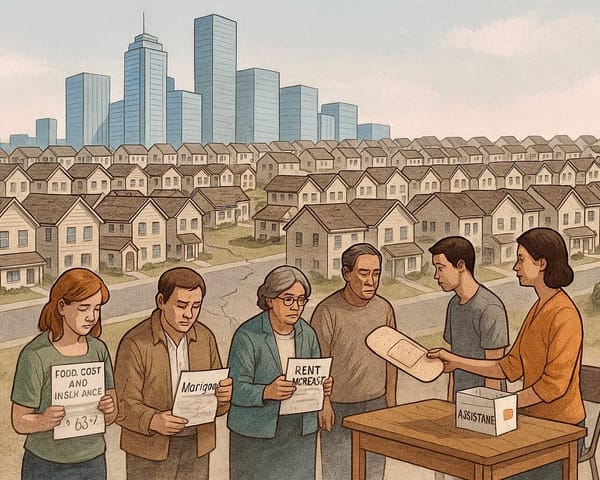If SNAP Goes Down…
The October 2023 SNAP failure gave us a brief taste of what might happen—it’s likely a 2025 repeat would be worse by orders of magnitude

Under notices issued by the Trump administration, no federal SNAP aid will be distributed on November 1 unless Congress restores funding. Multiple States have already warned residents that SNAP disbursements could be suspended entirely if the government shutdown continues.
A notice posted on the USDA web page reads as follows:
“Senate Democrats have now voted 12 times to not fund the food stamp program, also known as the Supplemental Nutrition Assistance Program (SNAP). Bottom line, the well has run dry. At this time, there will be no benefits issued November 01. We are approaching an inflection point for Senate Democrats. They can continue to hold out for healthcare for illegal aliens and gender mutilation procedures or reopen the government so mothers, babies, and the most vulnerable among us can receive critical nutrition assistance.”
With no new funds, the U.S. Department of Agriculture has instructed States to pause the issuance of November benefits—leaving roughly 42 million Americans at risk. Early warnings have already stirred panic in State capitals, with many officials admitting that without contingency action, low-income families may go hungry.
In October 2013, a cascading failure of the EBT (Electronic Benefits Transfer) system took down SNAP processing across 17 States. The cause was ultimately traced to a flawed backup test by vendor Xerox. At supermarkets from California to Mississippi, greeters could not verify balances; retailers scrambled to issue paper vouchers or refuse purchases. In Louisiana, the scenes were furious—some Walmart locations in Mansfield and Springhill were emptied as cardholders rushed in, hauling out “eight to ten grocery carts” each. Though local police responded, no widespread arrests or full-scale riots were logged; the crisis dissipated once systems were restored later that day.
The 2013 episode showed that a brief failure triggered visible chaos—desperate queues, emptied aisles, and store disputes. Under a prolonged cutoff, it cannot assumed that calm will hold. In fact, it’s likely that just the opposite would occur.
If SNAP payments are halted for just a day or two, first panic, then hardship will explode: recipients will rush to use existing balances; buyers may hoard staples; some stores might refuse transactions without verification. In neighborhoods already under strain, small disturbances—altercations, shoplifting attempts, confrontations at registers—are a virtual certainty. Local police could be drawn into tense standoffs, and stores may impose limits or shut early to avoid losses.
If the blackout stretches into several days, the risks of unrest (and worse) will cross a critical threshold. Here are worst-case scenarios that planners, law enforcement, and analysts quietly fear:
In some distressed districts, looting, as has been threatened, will likely break out. Frustrated residents might break into grocery outlets and wholesale stores. If security is weak and surveillance minimal, vandalism or theft could spread rapidly. Riots or mass protests demanding food could erupt in urban centers. If police intervene with force—tear gas, arrests—crowds may escalate the fight. In flashpoints, fires or property damage could follow—retail facades or storage units set ablaze in anger. Widespread shoplifting, not isolated “snatch and run” events but waves of organized theft, may overwhelm store defenses. Emergency services—fire, EMS, police—might be stretched thin trying to respond across multiple trouble spots. And political protest could fold into the disorder: food unrest will likely be fused with demonstrations over housing, inequality, policing, immigration and a plethora of other grievances real and imagined, complicating the response.
In 2025, the stakes are higher than in 2013. Inflation is already squeezing average households. Many SNAP recipients—like other Americans—live paycheck to paycheck. The shutdown’s timing—falling just before winter heating bills and holiday stress—amplifies and increases the perception of vulnerability.
Perhaps most significant, the country is far more divided than it was in 2013. Numerous influencers had already expressed their displeasure with the impending cutoff on social media, as collections and comments on these influencers by The Officer Tatum, Chez Chardaé and YT Wake ‘Em Up (just to list three) show. Additionally, a recent result of EBT being declined and the subsequent property destruction can be seen in THIS VIDEO by DDOE.TV1.
These videos provide a preview of likely responses to a SNAP cutoff, which we might see in the very near future—assuming, of course, that the Republicans continue to hold firm and the Democrats continue to use their constituents as leverage to provide taxpayer-funded healthcare to illegals, as TheDamaniFelder has said.
If federal aid remains offline for more than a few days, we could see visible fracture lines in communities that rarely make headlines. The 2013 system failure gave a glimpse of what’s possible under strain; today’s pressures will likely make 2025 repeat orders of magnitude worse.
Opinions do not reflect the views and opinions of ALPolitics.com. ALPolitics.com makes no claims nor assumes any responsibility for the information and opinions expressed above.




